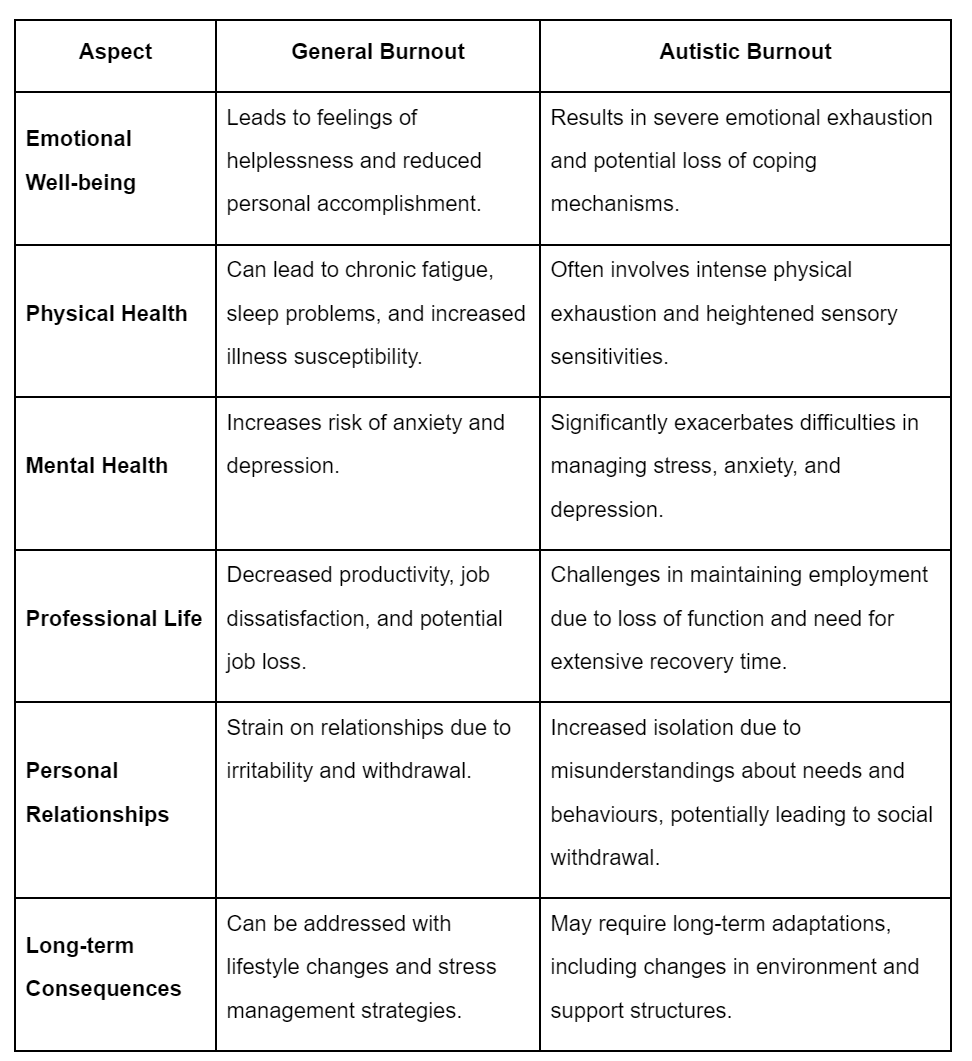In recent years, burnout has emerged as a significant issue affecting millions globally. It is characterised by deep emotional, physical, and mental fatigue and results from prolonged exposure to stressful conditions, both in personal and professional settings.
Burnout typically affects those faced with constant demands in their careers or personal lives, leading to a significant drop in productivity and a sense of helplessness. Understanding burnout is essential for everyone; however, it presents unique challenges for autistic people, a group for whom traditional definitions and solutions may not always apply.
While general burnout is widely recognised and discussed, autistic burnout has its own nuances and needs specialised discussion to fully grasp its impact on those affected.
What Is General Burnout?
General burnout refers to emotional, physical, and mental exhaustion brought on by excessive and prolonged stress. It’s typically linked to workplace pressures or intense personal responsibilities, and it can seriously affect our health and well-being. People experiencing burnout often feel overwhelmed, and when stress persists, motivation can wane, and feelings of ineffectiveness and lack of accomplishment can dominate.
Symptoms of general burnout include:
- Sleep disturbances: Such as trouble falling asleep or staying asleep and not feeling rested despite sleeping.
- Physical symptoms: Including headaches, digestive issues, muscle pain, or increased susceptibility to illnesses due to a lowered immune system.
- Feelings of negativism or cynicism related to work: This can manifest as a lack of enjoyment, pessimism, and a general detachment from the work environment and colleagues.
- Irritability or short temper: Minor irritations that one would typically brush off become bothersome, leading to disproportionate anger or frustration.
- Lack of concentration: Difficulty focusing on tasks at hand, which contributes to decreased productivity and effectiveness.
What Is Autistic Burnout?
This specific type of burnout affects autistic people and is distinguished by chronic life stress and a mismatch between demands and abilities without adequate support. Its unique challenges amplify the experience beyond typical manifestations of stress and exhaustion. It’s important to note that this can occur in any area of life. Whereas we often associate burnout with employment for the neurotypical population, autistic burnout frequently occurs as a result of everyday life. This condition leads to severe exhaustion, a loss of functional skills, and a decreased tolerance to stimuli, often lasting for months or even longer.
Researchers define autistic burnout as a syndrome conceptualised as resulting from chronic life stress and a mismatch of expectations and abilities without adequate support. Autistic people frequently describe this type of burnout as feeling utterly depleted, not just physically but also mentally and emotionally.
Characteristics of autistic burnout include:
- Persistent tiredness: Unlike typical fatigue, this exhaustion doesn’t improve with rest.
- Loss of skills: This may include difficulties with communication, memory, and executive function that were previously well-managed.
- Increased sensitivity to stimuli: Everyday sensory inputs become overwhelmingly intense, exacerbating the struggle to function normally.
Personal accounts from autistic adults highlight the pervasive and prolonged nature of their experiences with burnout. Many report that it significantly disrupts their daily lives, affecting everything from routine tasks to social interactions. Autistic burnout is often incorrectly diagnosed as other mental health conditions such as depression, anxiety, bipolar disorder, or borderline personality disorder. The intensity of these experiences can vary, but the common thread is the serious impact on overall well-being and quality of life.
Causes of Autistic Burnout
Autistic burnout arises from unique stressors that differ significantly from those typically associated with general burnout. These stressors are deeply intertwined with the daily experiences of autistic people living in a predominantly neurotypical world.
Key factors contributing to autistic burnout include:
- Masking autistic traits: Many autistic people feel compelled to hide their autistic characteristics to fit into social and professional settings. This masking can involve suppressing natural behaviours or forcing oneself to engage in socially acceptable ones, which is mentally exhausting and unsustainable over long periods.
- Sensory overload: Autistic individuals often have heightened sensitivity to sensory inputs such as sounds, lights, and physical sensations. Constant exposure to environments that are not sensory-friendly can lead to significant stress and eventual burnout.
- Unrealistic expectations and demands: Whether in educational, workplace, or social settings, autistic people frequently face expectations that do not consider their neurodiversity. The continuous effort to meet these expectations without adequate support can lead to severe stress.
- Social misunderstanding and lack of empathy: The lack of understanding from neurotypical people can exacerbate the feeling of isolation many autistic people experience. Misinterpretations of their needs or behaviours can lead to inadequate support in personal relationships and community services.
These causes create a cumulative stress effect that, over time, overwhelms the individual’s ability to cope, leading to burnout. The stress is not just from the effort of coping with everyday tasks but also from the emotional toll of continually striving to adapt to a world unaligned with their intrinsic needs.
Understanding these unique causes helps develop more effective support and interventions that can reduce the incidence of autistic burnout.
Comparing Impacts on Life and Health: General Burnout vs. Autistic Burnout
The impacts of both general and autistic burnout are significant, though they manifest differently across individuals’ lives and health:

This comparison reveals that while both forms of burnout lead to deterioration in quality of life, autistic burnout encompasses additional complexities, such as the loss of previously acquired skills and greater difficulties in social interactions, which require specific strategies for management and recovery.
Prevention and Management of Autistic Burnout
Effective strategies for preventing and managing autistic burnout focus on recognising the unique needs of autistic individuals and creating supportive environments that reduce stressors and promote well-being. Specific approaches could include:
Embracing Autistic Identity
- Validation and acceptance: Encourage acceptance of autistic traits and behaviours, reducing the need for masking, which is often a significant contributor to burnout.
- Community support: Engage with communities and networks that provide understanding and support for autistic needs, enhancing social connections without the pressure to conform.
Personalised Accommodations
- Work and education adjustments: Implement accommodations such as flexible scheduling, tailored workspaces, and the provision of sensory tools, which can significantly reduce work-related stress.
- Environmental modifications: Adjust home and social settings to create low-stress environments, such as using noise-cancelling headphones in loud spaces or having designated quiet areas.
Proactive Health Management
- Routine health checks: Regular medical and psychological support to manage the physical and mental health aspects of stress.
- Stress-reduction techniques: Techniques such as mindfulness, meditation, or engaging in hobbies can help maintain mental balance and reduce the overall stress load.
Educational and Advocacy Efforts
- Awareness campaigns: Increase awareness of autistic burnout in public and professional domains to ensure better recognition and understanding.
- Advocacy for rights: Promote and advocate for legal and societal changes that recognise and accommodate the unique needs of autistic people.
Autistic burnout requires more than awareness; it demands tailored solutions that cater specifically to the unique challenges faced by neurodivergent individuals. By acknowledging these challenges and implementing effective strategies, autistic individuals can find better support and recognition, leading to a reduced incidence of burnout and improved overall quality of life.
Get Help for Autistic Burnout with Specialised Support from The Revoke Programme
At The Revoke Programme, we aim to illuminate the specific impact of autistic burnout and the critical support needed to address it.
The path to recovery involves recognising the need for and implementing specialised approaches. With The Revoke Programme, you have a partner in this journey. Contact us to learn more about how we can support you or your loved ones in managing and preventing autistic burnout effectively.
References:
- https://link.springer.com/article/10.1186/1745-6673-4-31
- https://www.sciencedirect.com/science/article/abs/pii/B9780128009512000443
- https://www.sciencedirect.com/science/article/pii/S0165178121003206
- https://journals.sagepub.com/doi/abs/10.1177/13623613221147410
- https://pubmed.ncbi.nlm.nih.gov/32851204/
- https://www.liebertpub.com/doi/abs/10.1089/aut.2020.0083
- https://www.liebertpub.com/doi/full/10.1089/aut.2020.0074
- https://link.springer.com/article/10.1007/s41252-020-00180-9
- https://www.hindawi.com/journals/aurt/2012/835847/



